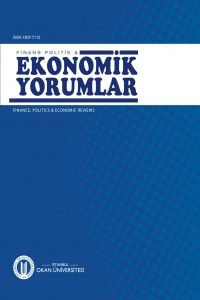Türkiye ile AB Arasındaki Kişi Başına Gelir Yakınsaması: Farklardaki Fark Analizi
Kalkınma ekonomisinin en çok tartışılan konularından bir tanesi, ülkeler arasındaki büyüme farklılıklarının nedenleri olmuştur. Sürdürülebilir kalkınmanın ana unsuru, bu farklılıkların ortadan kaldırılması olarak düşünülmüş ve bu bağlamda, literatürde neoklasik ve içsel büyüme teorilerinin oluşturduğu yakınsama hipotezleri ortaya konmuştur. Neoklasik yakınsama hipotezi, ülkeler arasındaki büyüme farklılıklarının azalacağını belirtmesine karşın; içsel yakınsama hipotezi ise böyle bir sürecin söz konusu olmayacağını işaret etmiştir. Bu hipotezlerin geçerliğini test edebilmek amacıyla, Türkiye ile euro bölgesi içinde bulunan 17 AB üyesi ülke arasında “farklardaki fark” analizi kullanılmıştır. Gümrük Birliği’nin yakınsama süreci üzerindeki etkisinin belirlenebilmesi için 1981 – 2010 dönemi, 1981 – 1995 ve 1996 – 2010 alt dönemleri olmak üzere ikiye ayrılmıştır. Analiz bulguları, 1996 – 2010 döneminde Türkiye ile Almanya ve Finlandiya arasında mutlak bir ıraksamanın; Türkiye ile Yunanistan, İrlanda, Hollanda, İspanya, Avusturya, Güney Kıbrıs Rum Kesimi, Slovenya, Estonya, Malta, Slovakya ve Lüksemburg arasında ise mutlak bir yakınsamanın olduğunu göstermiştir
Anahtar Kelimeler:
Yakınsama, Farklardaki Fark, Zaman Serisi Analizi, Türkiye
Per Capita Income Convergence Between Turkey and EU: Difference-in-Differences Analysis
One of the most debated issues of the development economics was the causes of the growth differences between countries. The main element of the sustainable development was thought to be eliminated of these differences and hence, the convergence hypothesis which were formed by neoclassical and endogenous growth theories were introduced in the literature. Although neoclassical convergence hypothesis emphasized that the growth differences between countries would decrease, endogenous convergence hypothesis pointed out that such a process would not exist. In order to test the validity of these hypothesis, the “difference-in-differences” analysis was used between Turkey and the 17 EU member countries in the euro zone. To determine the effect of the Customs Union on the convergence process, the period of 1981 – 2010 was divided into two sub-periods as 1981 – 1995 and 1996 – 2010. The results of the analysis showed that there was an absolute divergence between Turkey, Germany and Finland; there was an absolute convergence between Turkey, Greece, Ireland, Netherlands, Spain, Austria, Cyprus, Slovenia, Estonia, Malta, Slovakia and Luxembourg in the period of 1996 – 2010
Keywords:
Convergence Difference-in-Differences, Time Series Analysis, Turkey, Euro Zone,
- ISSN: 1307-7112
- Başlangıç: 1963
- Yayıncı: İstanbul Okan Üniversitesi
